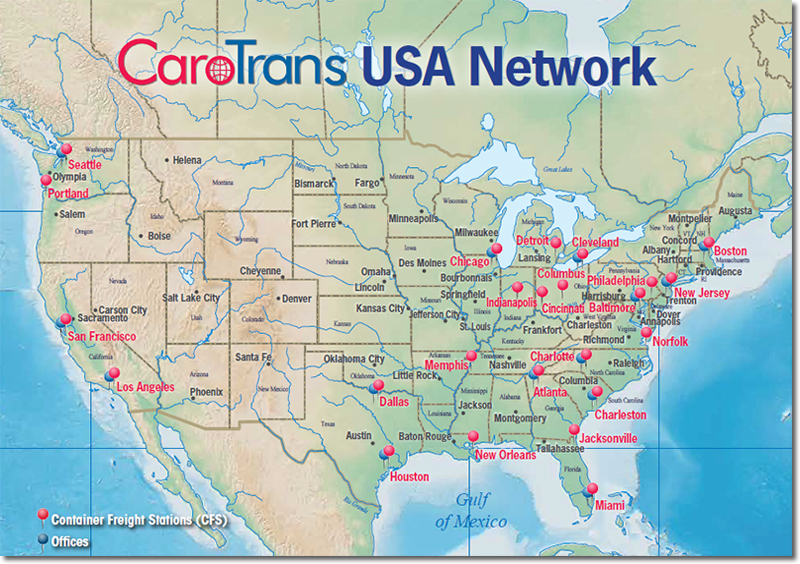Time for Shippers to Think Again About Diverting US West Coast Cargo to the East
The congestion that began to form in west coast ports in July 2014, and which then peaked in January and February this year as labor agreement talks stalled, destroyed the schedule reliability of ocean carriers serving the region – at its worst, just 10% of sailings arrived on time.
US shippers that diverted Asian imports to east coast ports to avoid the heavily congested Pacific coast container terminals could do well to review their strategy following a return to normality on the west coast.
That is the view of liner consultancy SeaIntel, which has analysed the two ex-Asia tradelanes since January 2012 and concluded that schedule reliability to the US west coast is consistently at a higher level than to the east coast.
During the two-year period to December 2013, SeaIntel said, there was “not a single month” where schedule reliability was at a higher level to the east coast than to the west. In fact, throughout this period its data shows that the reliability gap varied from 2.4 to 14.9 percentage points in favor of the west coast.
The congestion that began to form in west coast ports in July 2014, and which then peaked in January and February this year as labor agreement talks stalled, destroyed the schedule reliability of ocean carriers serving the region – at its worst, just 10% of sailings arrived on time.
Despite these bleak negative months, the overall score, for the full January 2012 to April 2015 period covered by SeaIntel, still has the west coast ahead with a score of 74.1%, compared with 70.9% for east coast services.
The one obvious reason for the disparity reliability is that the voyage from Asia to the US east coast is longer, thus increasing the risk of adverse weather, while the requirement of Panama or Suez Canal transits also present a potential delay in the schedule.
SeaIntel notes additionally that east coast services include more ports in their itinerary than respective strings to the west coast, further increasing the chance of delays.
Moreover, the northern east coast ports, such as New York, are far more likely to face weather-related stoppages in winter – an almost non-existent problem for Californian ports.
In theory, carriers should have more buffer time for the longer east coast transits and, therefore, more opportunity to regain schedules by speeding up delayed vessels, but SeaIntel found this to be “overwhelmingly not the case”, with carriers reluctant to increase fuel consumption by steaming faster.
Given the inferior schedule integrity of Asia-US east coast services, and with several of those ports also suffering congestion at their terminals, it remains an enigma as to why US shippers should continue to route traditional west coast gateway cargo to the east coast.
It is also more expensive: current Asia-US east coast spot freight rates are around $3,200 per 40ft, which is double to those on offer to west coast ports, a factor that has encouraged carriers to boost their east coast capacity – not only during the labor dispute, but also following it with six new strings added since the end of last month.
The addition of around 27,000 extra slots a week on Asia-US east coast services has so far not been reflected in any severe plunge in spot rates.
By introducing the extra services to the east coast, carriers have reacted to market demand from shippers, suggesting that diverted cargo will remain diverted for some time.
Source: The LoadStar
Supply Chain Managers May Be Considering New Seaport Options, Says Report
Disruptions by dockworkers on the U.S. West Coast at the end of last year added to the congestion woes of Los Angeles and Long Beach, thereby raising the profile of competing ocean cargo gateways like Miami and New York/New Jersey.
East Coast ports are growing at a faster rate than their West Coast counterparts, according to the inaugural edition of CBRE Group, Inc.’s “2015 North America Ports & Logistics Annual Report.”
But even as the East Coast ports are gaining ground, the ports of Los Angeles and Long Beach still topped the report’s first-ever “Ports and Logistics Index,” thanks to infrastructures that is well-suited to handle the largest cargo container ships, their proximity to Asian export markets, a strong local economy and a deep industrial real estate market.
Disruptions by dockworkers on the U.S. West Coast at the end of last year added to the congestion woes of Los Angeles and Long Beach, thereby raising the profile of competing ocean cargo gateways like Miami and New York/New Jersey. Even the little upstart of New Orleans got into the action. Today, they’re all contenders, say industry experts, especially as the Panama Canal expansion finally nears.

According to John Morris, Americas services leader for the industrial real estate firm Cushman and Wakefield, containerized imports through Los Angeles and Long Beach were down 26 percent in January, but up sharply at Savannah and other East Coast ports.
New York and New Jersey, Seattle/Tacoma Alliance and Oakland round out the top five ports on the Index, which ranks the top 15 North American ports based port infrastructure capabilities and the strength of the local industrial real estate market.
“Although the location needs of supply chain users are somewhat fixed given existing distribution centers and customer locations, these networks are always evolving and adjusting to meet increasingly complex inventory requirements,” said David Egan, head of industrial research in the Americas for CBRE. “As ports across North America continue to address operational efficiencies caused by greater cargo volumes, labor disputes and a shortage of workers, supply chain users are exploring diversification strategies that move some portion of inbound cargo from the congested West Coast ports to East and Gulf Coast ports.”
When it comes to port infrastructure alone - which measured total twenty-foot equivalent unit (TEU) volume, long-term growth in annual TEU volume and year-over-year growth in TEU volume - Los Angeles, New York and New Jersey and Long Beach took the top spots, with Savannah and Virginia (Norfolk) at #4 and #5, respectively.
With respect to the real estate ranking component - which was weighted less heavily in the overall rankings than port infrastructure - the characteristics measured included a market’s total size, availability of existing industrial space, demand activity, historical and forecasted construction rates, rent growth and each market’s position in its own cycle.
The markets with healthy amounts of existing and planned space for their size, and which have experienced growth during the current recovery cycle but have not yet reached their peaks, rose to the top of the list. Los Angeles and Long Beach were the top-ranked markets in this component, with Houston, Oakland and Seattle/Tacoma rounding out the top five.
Patrick Burnson, Executive Editor
Related: The Real Economic Impact of Mega-Container Ships
















